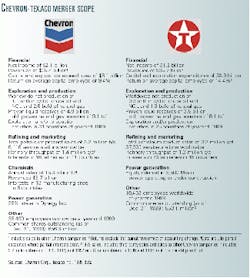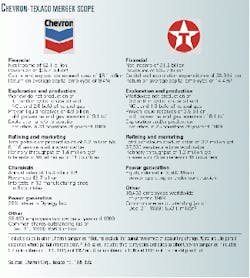COMPANY NEWS: Chevron, Texaco agree to merge in all-stock deal
Chevron Corp. early last week confirmed widely rumored speculation that it and fellow US oil company Texaco Inc. have agreed to a merger based on a stock acquisition valued at about $35 billion. The deal will create an energy combine with a market capitalization at some $100 billion.
ChevronTexaco Corp., as the combined company is to be known, expects yearly cost savings of "at least $1.2 billion" within 6-9 months of the merger's completion. The new combine said its enlarged global operations would represent reserves of 11.2 billion boe, production of 2.7 million boe/d, and assets of $77 billion (see table).
Within the US, according to the companies, the newly formed ChevronTexaco will be the third largest producer of oil and gas with production of 1.1 million boe/d, and will hold the nation's third largest reserve position, with 4.2 billion boe of proved reserves.
Under terms of the agreement, Texaco shareholders will receive 0.77 of a share of Chevron for each share of Texaco stock. Based on Chevron's Oct. 13 closing price of $84.25 in New York Stock Exchange composite trading, the offer values Texaco at $64.87 a share, an 18% premium to its Oct. 13 closing of $55.13.
Merger details
Current Chevron Chief Executive Officer Dave O'Reilly will serve as chairman and CEO of ChevronTexaco, which will be headquartered in San Francisco.
Peter Bijur, Texaco chairman and CEO, will become a vice chairman of the combined company with responsibility for downstream, power, and chemicals operations, while Richard Matzke, Chevron vice-chairman for upstream operations, will retain those responsibilities in the combined company.
The merger-the latest in wave of takeovers that formed the likes of energy giants ExxonMobil Corp. and TotalFinaElf SA-was described by O'Reilly as "good news" for the US because it positions ChevronTexaco as a "much stronger US-based global energy producer better able to contribute to the nation's energy needs."
That's good news for the country, O'Reilly says, because the US will have an additional top-tier energy company better positioned to compete effectively with the international supermajors.
O'Reilly said the new company's shareholders would see more robust financials both through "significant" cost reductions and "because [ChevronTexaco will] have a much broader mix of quality assets, skills, and technology."
Bijur added, "Texaco and Chevron are natural partners, whose historic relationship and operational fit are highly complementary. We know each other well, and we already have long, highly productive experience working together in both the upstream and downstream, giving us an advantage in integrating the companies."
The combined company would be the biggest producer in the gas-prone Gulf of Mexico, the largest holder of deepwater acreage in the gulf, and the low-cost producer in California's San Joaquin Valley, with growth positions in Canadian gas plays, said O'Reilly.
The combination also increases the scale and scope of the new company's West African holdings. ChevronTexaco will be the No. 1 producer off Angola, with an expanded deepwater position, and No. 2 off Nigeria, where it will hold the most deepwater acreage. The merger also will provide the company with strong positions in six other countries in that region, O'Reilly said.
ChevronTexaco also will be top producer in the Caspian region and the No. 1 foreign producer in Venezuela, and it will hold the top exploration position with nine deepwater blocks off Brazil, he said.
The merger will enhance the scale and efficiency of the companies' operations in Indonesia and China and provide expanded gas platforms for the Asia-Pacific market in Australia, Thailand, and the Philippines, said O'Reilly.
Company officials recognize that the US Federal Trade Commission will probably insist on divestitures of some refining and marketing facilities.
Chevron already has about 40% of the California refined products market, said Ronald B. Gold, a consulting senior adviser to PIRA Energy Group. "If you throw in Equilon's operations in Washington state, that gives them about 36% of the West Coast market. That's too big for the FTC to ignore," he said.
Equilon Enterprises LLC and Motiva Enterprises LLC were created in 1998 by the combination of the US refining and marketing businesses of Shell Oil Co., Texaco, and Star Enterprises-a joint venture between Texaco and Saudi Refining Inc. (SRI). Shell and Texaco own 56% and 44%, respectively, of Equilon. Shell, Texaco, and SRI own about a third each of Motiva.
Officials of Shell Oil Co. and SRI confirmed they are in discussions with Texaco concerning possible restructuring of the ownership of those two Alliance companies. Shell and SRI officials said they are committed to US refining and marketing. However, they said a number of significant issues must be ironed out among the parties.
Savings, benefits
Cost-cutting remains the paramount reason for the merger, with some $700 million of the anticipated $1.2 billion in cost savings coming from "more efficient exploration and production activities," and another $300 million shaved through the consolidation of corporate functions. Some 4,000 jobs worldwide-representing a 7% reduction of its present workforce to some 57,000-will be made redundant through the merger.
In the upstream sector, said ChevronTexaco, the combination would "significantly strengthen positions in core producing areas in North America and the North Sea [and] create an outstanding portfolio of growth opportunities in Latin America and the Asia-Pacific region."
Downstream, by integrating the operations of Caltex-the 65-year-old international refining and marketing joint venture between Chevron and Texaco-the new company said it would "realize efficiencies from streamlined decision-making and management."
ChevronTexaco said the merger would also allow for "an enterprise approach" to lubricants-including its Havoline and Delo brands, trading, international markets, and customers-and would build on existing fuels and marine marketing joint ventures.
The new company hopes to capitalize on the merged strength of Texaco's power and gasification business, with equity interests in 3,500 Mw of power operating or under construction, and Chevron's 26% stake in Dynegy, Inc., to give itself a leg up in the fast-growing power and energy convergence businesses (see related story, p. 29).
A combination of the two giants is also to create a new company with "leading technologies in its core businesses." And ChevronTexaco will benefit from an enlarged portfolio in advanced technologies, e-business ventures, and alternate energy, such as fuel cells and gas-to-liquids conversion.
Corporate closeness
With their Caltex international refining and marketing joint venture, Chevron and Texaco should move faster in fusing their similar cultures, without the disruption of upstream activity experienced in other megamergers, company officials said.
But reality will likely prove very different from that promise, said James K. Wicklund at Dain Rauscher Wessels Inc.
He expects another significant drop in upstream spending as a result of the proposed merger, which will put more emphasis on independent operators picking up the slack in US exploration and production and more pressure on oil field service companies to research and develop new technology for the future.
"The majors aren't spending their E&P budgets this year, primarily as a result of the megamergers of 2 years ago," Wicklund said.
"Like those other mergers, this one will go through a period of 'who's in charge, whose projects have priority, who makes the decisions,'" he said. "It will be at least 12 months from the close of the merger-not its announcement-before spending starts to return to normal."
In separate telephone conferences with financial analysts and journalists Oct. 16, however, company officials insisted that the unique closeness shared by Chevron and Texaco will give them a leg-up in completing their megamerger faster and more smoothly than their predecessors.
"We're historic partners with a lot in common," O'Reilly told industry analysts during a telephone conference following the merger announcement. Members of the two companies "are already talking as one team" in their efforts to improve the financial strength and flexibility of the new ChevronTexaco.
"If ever there was a deal to be done, a consolidation to take place, this is it," said Bijur, in that same session. "We know each other better than any other two companies." The proposed merger "makes good sense for the upstream, good sense for the downstream, and terrific sense for the midstream."
The two major integrated US companies share a common goal to "create a juggernaut" that will shoulder aside Shell Oil Co. to become the third largest US producer of oil and gas, behind top producer BP and second-place Exxon- Mobil.
Analysts say it has taken nearly a year on average to get regulatory approvals for other recent megamergers.
O'Reilly claims the two companies "won't stand still" on upstream operations while awaiting regulatory approval for the merger and then combining operations. But of the $1.2 billion of synergy savings that ChevronTexaco expects to realize within 9 months of completing that merger, $700 million will come out of the combined upstream operations.
That includes $300 million from exploration, with a potential 25% reduction of the combined exploration budgets; $350 million from production; and $50 million from research and development, officials said.
Texaco's production has been declining as that company disposes of non-core operations, as Chevron did previously. Meanwhile, Chevron is pursuing strategies aimed at increasing its production by 4%/year.
Once the merger is consummated, O'Reilly claims, the top talents gleaned from the two companies will be able to high-grade a bigger sample of the best exploration and production opportunities to get more production from less spending.
Even the cutback in R&D spending doesn't signal "a reduced commitment" to that important aspect of future growth. "This is truly a case where 1 plus 1 equals 3," O'Reilly said.
The new company plans to become "No. 1 in shareholder value" with higher returns on capital investments in all aspects of the current oil and gas industry and with strong branches in industries of the future.

